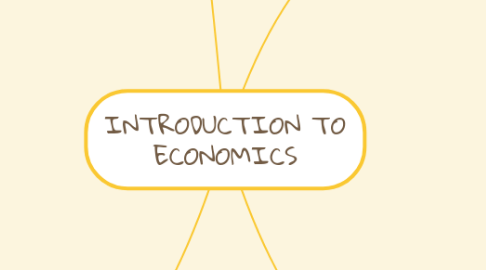
1. PRODUCTION POSSIBILITIES CURVE (PPC)
1.1. combinations of two goods which can be produced with the existing resources
1.2. Assumptions
1.2.1. economy is producing only two goods
1.2.2. resources available are fixed in both quantity and quality
1.2.3. current technology is fixed
1.2.4. economy is operating at full employment
1.3. Shapes of PPC
1.3.1. concave, increasing opportunity cost
1.3.2. convex, decreasing opportunity cost
1.3.3. linear, constant opportunity cost
1.4. Factors that Influence Shift of PPC
1.4.1. increase or decrease resources
1.4.2. improved or inferior level of technology
1.4.3. increase economic growth or down turn economic growth
1.4.4. increase or decrease in population
2. BASIC ECONOMIC PROBLEMS
2.1. What to produce
2.1.1. refers to the type of goods and services to be produced.
2.2. How much to produce
2.2.1. refers to quantity to be produced, depends on society's demand as well as related to scarce
2.3. How to produce
2.3.1. refers to methods or techniques of production
2.4. For whom to produce
2.4.1. depends on the distribution of income in society and purchasing power
2.5. COMMAND ECONOMY/CENTRAL PLANNING/SOCIALIST ECONOMIC SYSTEM
2.5.1. Characteristics
2.5.1.1. government makes all economic decisions without the involvement of private sector
2.5.1.2. government owns all factors of production in the economy
2.5.1.3. society must abide by the government's directives
2.5.1.4. equal distribution of income
2.5.2. Advantages
2.5.2.1. government can direct the nation's resources to produce desirable goods and services
2.5.2.2. prices of goods and services are controlled by the state
2.5.3. Disadvantages
2.5.3.1. no economic freedom in command economy
2.5.3.2. no price system were made
2.6. FREE MARKET ECONOMY' FREE ENTERPRISE/CAPITALIST ECONOMIC SYSTEM
2.6.1. Characteristics
2.6.1.1. resources owned by private sectorsand no government intervention in making economic decisions
2.6.1.2. firms/individual have liberty to make their own free economy
2.6.1.3. price mechanism is important indicator in the free economy
2.6.1.4. maximise profit and minimise cost
2.6.2. Advantages
2.6.2.1. freedom of choice
2.6.2.2. have right to own properties
2.6.3. Disadvantages
2.6.3.1. wide gap between rich and poor
2.6.3.2. existence of unemployment
2.7. REGULATED MARKET ECONOMY/MIXED ECONOMY SYSTEM
2.7.1. Characteristics
2.7.1.1. resources owned by both private and government
2.7.1.2. government intervenes by providing public goods
2.7.1.3. private sectors free to own wealth but levied with taxes
2.7.1.4. private sectors are free and independent to make economic decisions
2.7.2. Advantages
2.7.2.1. variety of goods and services produced by the private sectors and government sectors provide affordable price
2.7.2.2. economic activities more stable and organise
2.7.3. Disadvantages
2.7.3.1. allows excessive intervention of the government, especially if its influenced by political factors
2.7.3.2. government may limit company sizes to reduce monopoly power
2.8. ISLAMIC ECONOMIC SYSTEM
2.8.1. Characteristics
2.8.1.1. production of goods and services based on Shari'ah
2.8.1.2. private and government sectors are free to make economic decisions and gain profit
2.8.1.3. production of goods and services depends on hierarchy of needs
2.8.2. Advantages
2.8.2.1. production depends on the classification of goods and services in Islam
2.8.2.2. best allocation of wealth and fair distribution of income through concept zakat, sadaqqah and so on
3. DEFINITION OF ECONOMICS
3.1. social science that studies how society allocates scarce resources to fulfil their unlimited wants.
3.1.1. Factors of Production
3.1.1.1. Land
3.1.1.1.1. includes all natural resources, derived from the earth and land
3.1.1.2. Labour
3.1.1.2.1. people who contribute their energy mentally and physically
3.1.1.3. Capital
3.1.1.3.1. wealth used for production
3.1.1.4. Entrepreneur
3.1.1.4.1. organises the other factors of production
3.1.2. Differences between Goods and Services
3.1.2.1. Goods
3.1.2.1.1. physical form
3.1.2.1.2. tangible things
3.1.2.2. Services
3.1.2.2.1. not physical form
3.1.2.2.2. intangible things
3.2. BRANCHES OF ECONOMICS
3.2.1. Microeconomics
3.2.1.1. deal with individual and specific units of economics
3.2.2. Macroeconomics
3.2.2.1. deal with economics as a whole
3.2.3. Differences between Conventional and Islamic Perspectives
3.2.3.1. Conventional perspectives
3.2.3.1.1. how organise scarce resources to fulfil their unlimited wants
3.2.3.2. Islamic perspectives
3.2.3.2.1. imbued with Islamic values that are based on the principles of Shari'ah
4. BASIC ECONOMIC CONCEPTS
4.1. Scarcity
4.1.1. arises due to limited resources and unlimited wants
4.2. Choice
4.2.1. best choice possible due to scarcity
4.3. Opportunity Cost
4.3.1. the second best alternative and its benefits that is given up
